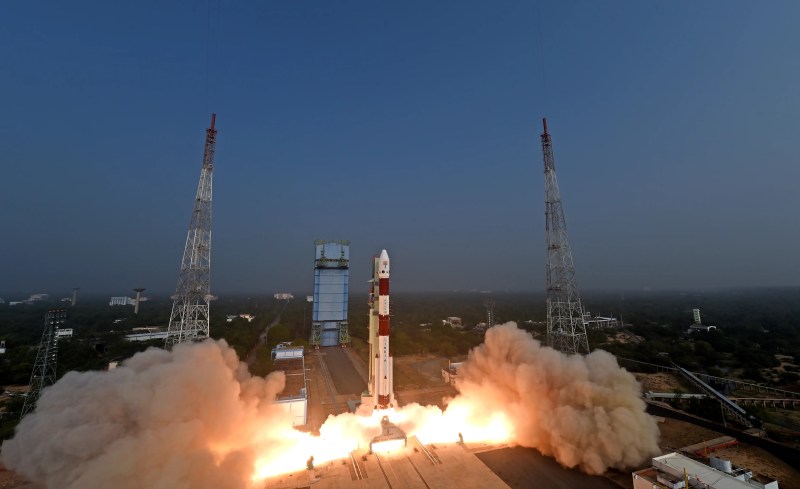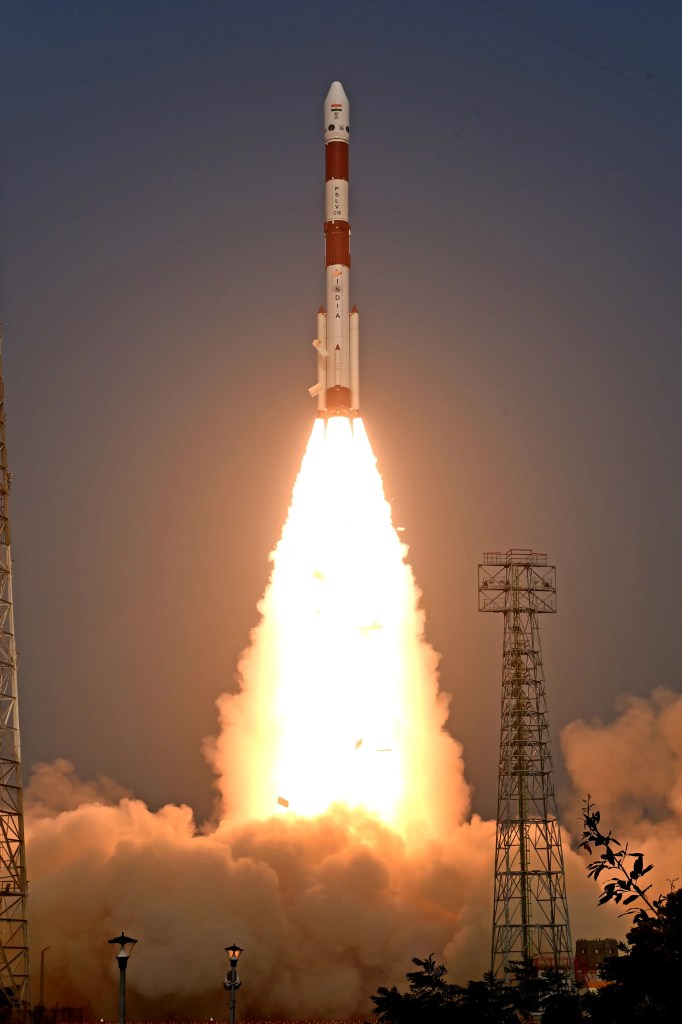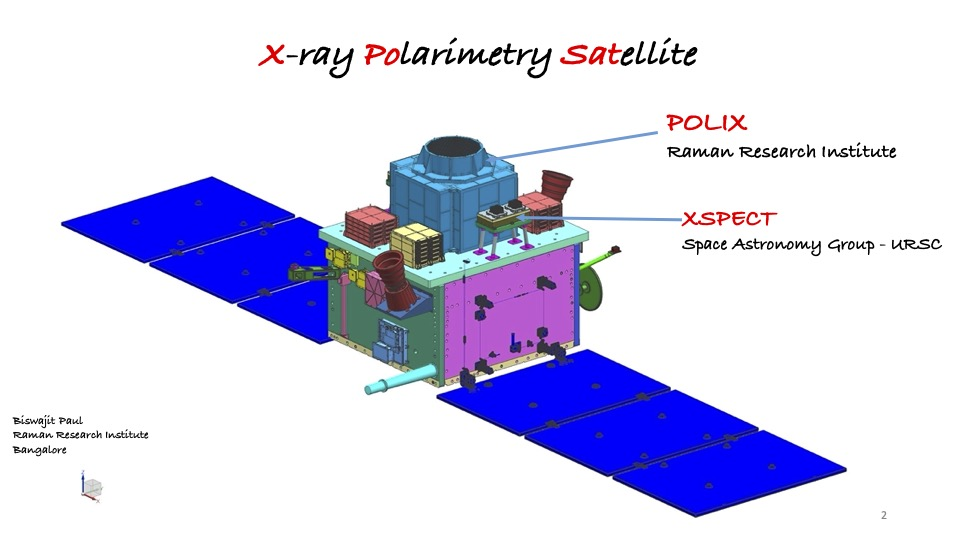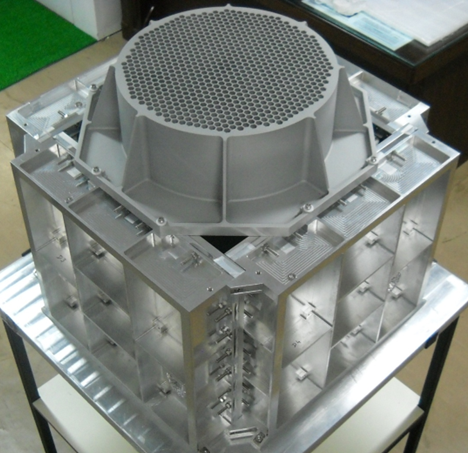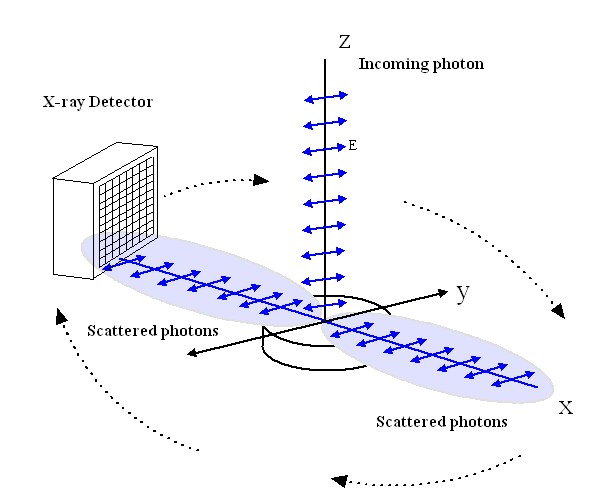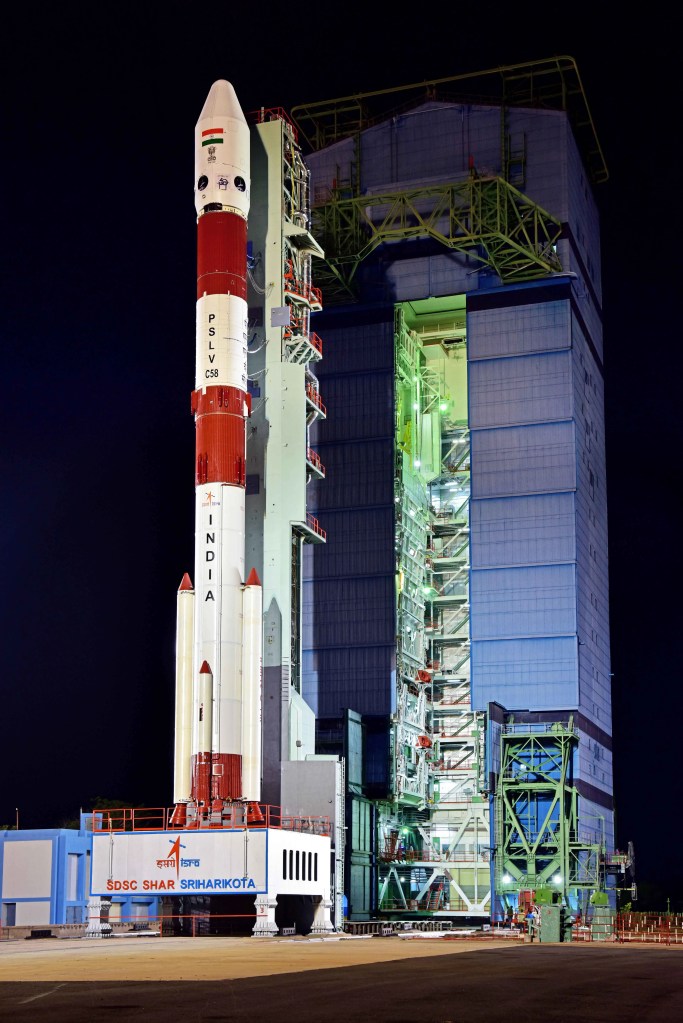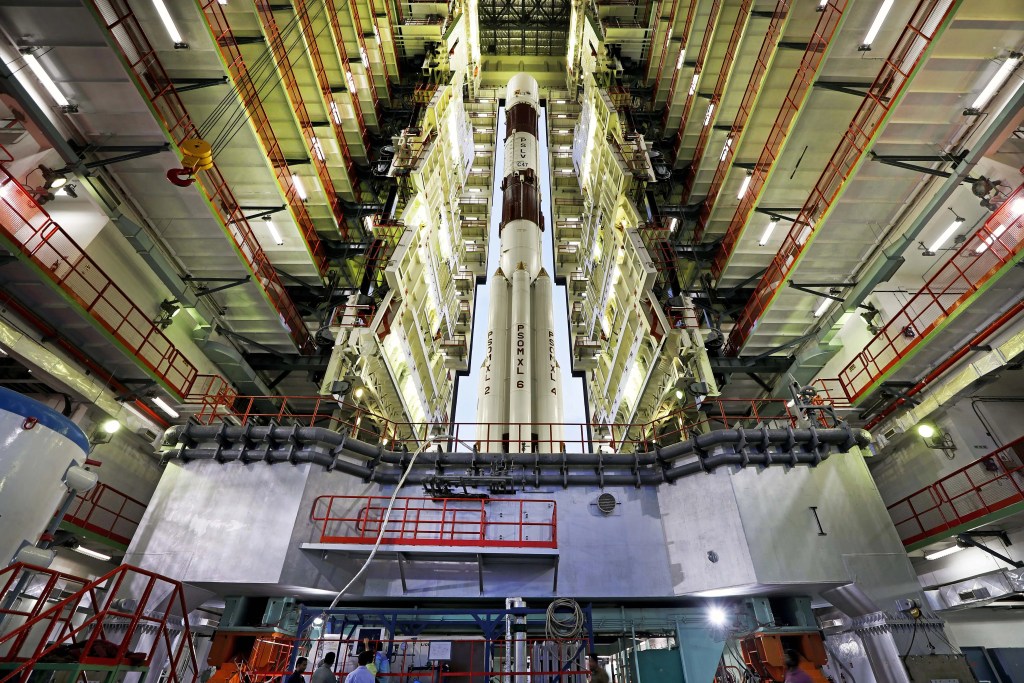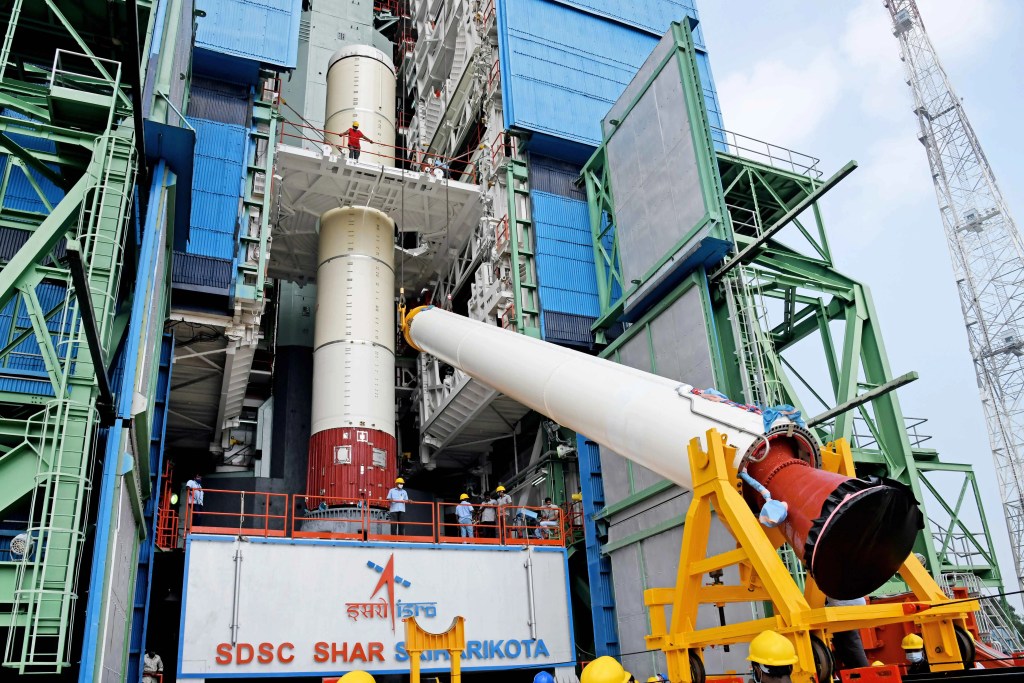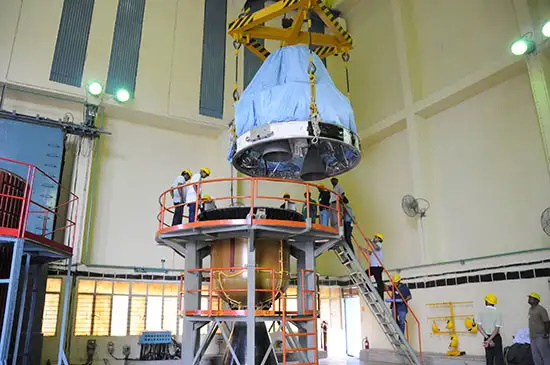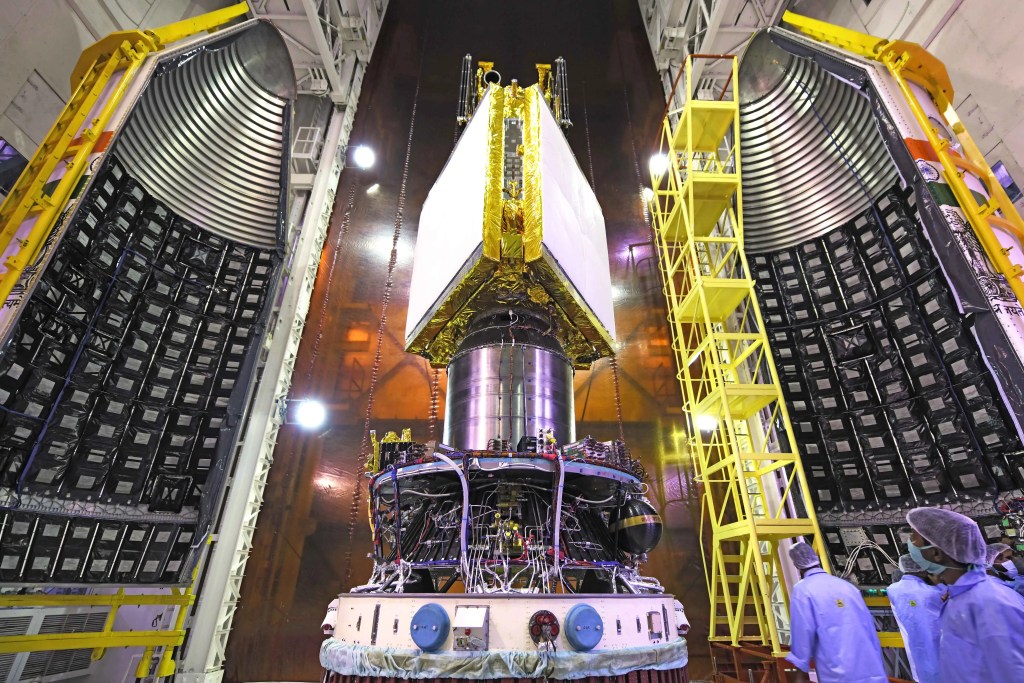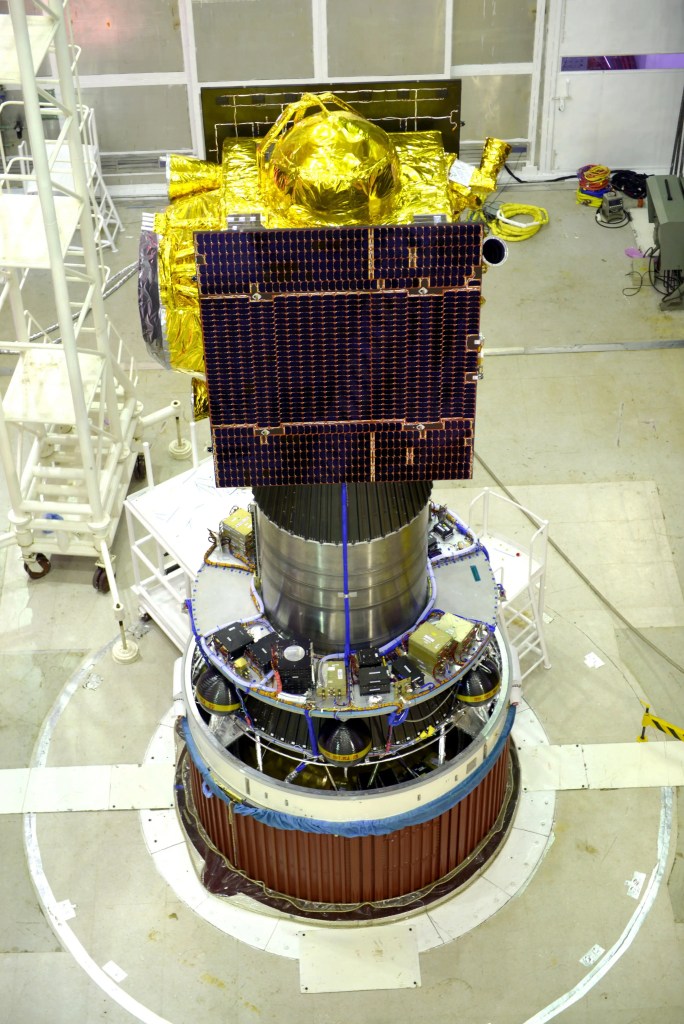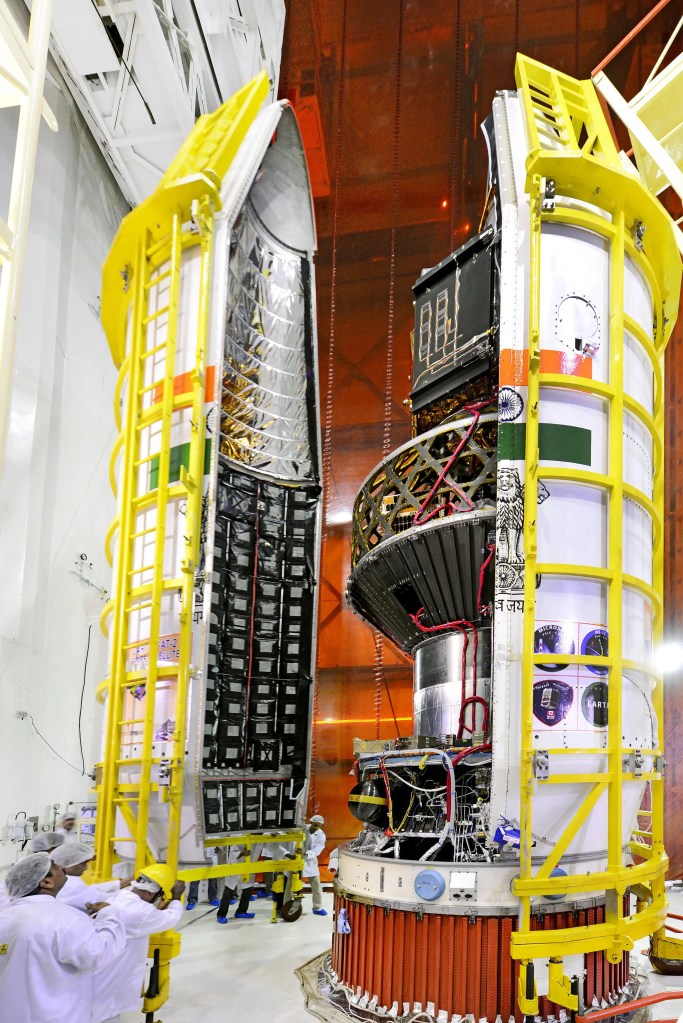Featured image’s credit: ISRO
Liftoff Time | January 1, 2024 – 03:40 UTC | 9:10 IST |
|---|---|
Mission Name | XPoSat, or X-ray Polarimeter Satellite |
Launch Provider | The Indian Space Research Organization (ISRO) |
Customer | The Indian Space Research Organization (ISRO) |
Rocket | Polar Satellite Launch Vehicle, or PSLV-DL (PSLV-C58) |
Launch Location | First Launch Pad (FLP) located at the Satish Dhawan Space Centre, on the Sriharikota island, India |
Payload mass | 480 kg (~1,060 lb) |
Where did the satellite go? | A circular low-Earth orbit at 650 km (~400 mi) in altitude, and 6 degrees of inclination |
Did they attempt to recover the first stage? | No. The PSLV rocket does not have this capability |
Where did the first stage land? | It crashed into the Bay of Bengal |
Did they attempt to recover the fairings? | No. The PSLV rocket does not have this capability |
Were these fairings new? | Yes |
This was the: | – 1st orbital launch attempt in 2024 – 1st PSLV mission in 2024 – 4th PSLV-DL mission overall – 60th PSLV mission overall – 1st ISRO mission in 2024 – 92nd ISRO mission overall |
Where to watch | Official replay |
What’s All This About?
The Indian Space Research Organization (ISRO) launched its first polarimeter observatory, XPoSat, on a PSLV-DL rocket. It’s worth noting the DL variant of PSLV is quite rarely used, this being only its fourth flight. In order to carry out this mission, the launch vehicle lifted off from Sriharikota Island, in India. Specifically, it left from the First Launch Pad at the Satish Dhawan Space Centre. After the launcher finished its task, the spacecraft entered a low-Earth orbit, where it will operate for five years.
How Did It Go?
As expected, the Indian rocket took to the skies riding the power of solid rocket motors. The flight progressed without issues, nominally achieving all of its milestones. When the time came, the PS4 deployed XPoSat into its target orbit, with the stage descending afterward. Once at a lower altitude and passivated, it started operating as orbital platform. According to Indian authorities, the hosted experiments will be complete in a period of about a month.
What Is XPoSat?
The X-ray Polarimeter Satellite, or XPoSat, is an Indian observatory aimed at studying many bright x-ray sources, i.e., black holes, and neutron stars, among others. In order to materialize this project, the spacecraft’s development fell under the responsibility of ISRO. Similarly, the agency is in charge of its operation. This mission marks a significant milestone for the country, as India has never before launched payloads dedicated to x-ray polarimetry. In fact, there has been only one such satellite worldwide before: the NASA-led mission IXPE.
According to ISRO, this mission pursues the following objectives:
- Measure the polarization of X-rays in the energy band of 8-30 keV emitted by approximately 50 potential cosmic sources using the POLIX payload.
- Conduct long-term spectral and temporal studies of cosmic X-ray sources in the energy range of 0.8-15 keV using the XSPECT payload.
- Perform polarization and spectroscopic measurements of X-ray emissions from cosmic sources using the POLIX and XSPECT payloads, respectively, within a common energy band.
Further scientific payloads, ten commercial experiments will fly aboard the orbital platform, or fourth stage, identified as POEM-3. It will begin its operation not only after XPoSat’s deployment, but also after changing its orbit. Altitude will decrease down to the 350 km (~220 mi) mark, while inclination will increase up to 9.6 degrees. In order to do this, the uppermost stage needs to reignite twice. Hosted payloads on this platform come both from ISRO, and from the Indian National Space Promotion and Authorization Center (IN-SPACe).
Regarding POEM, you can read more at the bottom of the PSLV’s section. Here is a list of payloads on POEM-3, as reported by ISRO:
| Payload | Purpose | Agency/Company |
|---|---|---|
| Radiation Shielding Experimental Module (RSEM) | Evaluation of tantalum coating effectiveness. | TakeMe2Space |
| Women Engineered Satellite (WESAT) | Comparison of solar irradiance and UV index. | LBS Institute of Technology for Women |
| BeliefSat-0 | Amateur radio satellite. | K J Somaiya Institute of Technology |
| Green Impulse TrAnsmitter (GITA) | Green bipropellant CubeSat propulsion unit. | Inspecity Space Labs Private Limited |
| Launching Expeditions for Aspiring Technologies – Technology Demonstrator (LEAP-TD) | Demonstration of a subsystem of a microsatellite. | Dhruva Space Private Limited |
| RUDRA 0.3 HPGP | Green monopropellant thruster. | Bellatrix Aerospace Private Limited |
| ARKA-200 | Heaterless hollow cathode for Hall thrusters. | Bellatrix Aerospace Private Limited |
| Dust Experiment (DEX) | Interplanetary dust count measurement. | PRL, ISRO |
| Fuel cell Power System (FCPS) | Demonstration of fuel cells. | VSSC, ISRO |
| Si based high energy cell | Demonstration of silicon based high energy cells. | VSSC, ISRO |
The Spacecraft — XPoSat’s Bus
The satellite was developed based on the Indian MiniSatellite 2 (IMS-2) bus. Among its characteristics, it is possible to mention it presents a maximum mass of 250 kg (~550 lb). On top of that, it can carry up to 200 kg (~440 lb) in payload. Its solar arrays produce 850 W at the beginning of its life, on average providing 250 W for the payload. The IMS-2 showcases 3-axis stabilization by means of four reaction wheels, and a reaction control system. The latter stores 21 kg (~46 lb) of monopropellant to burn using four 1.0 N (~0.2 lbf) thrusters, and another four 0.20 N (~0.04 lbf) ones.
XPoSat’s Instruments
As mentioned, two different instruments provide XPoSat with the capability of making observations of X-rays and their properties. Each of these payloads, POLIX and XSPECT, will operate in different energy ranges. Moreover, they will attempt to gain insights about different properties of this electromagnetic radiation — X-rays.
Polarimeter Instrument In X-rays (POLIX)
This instrument’s development was provided by Raman Research Institute (RRI) in a collaborative effort with the U R Rao Satellite Centre (URSC). POLIX features a mass of no more than 125 kg (~275 lb), while measuring approximately 65x65x60 cm (~25x25x23 in). It consumes about 80 W of electrical power, and it requires XPoSat to spin at 0.5 to 5 rpm. All this considered, its task will be to carry out observations of high energy X-rays in the band from 8 keV up to 30 keV.
It works by using a collimator, where the field of view of the instrument experiments a restriction. In effect, POLIX is able to see only through an angular window of 3 degrees by 3 degrees. As a result, it can focus on a single emitting body. Secondly, the incoming electromagnetic radiation hits a scatterer, dispersing them in all directions — though not uniformly so. Made of lithium and beryllium for low absorption, this scatterer sends more rays in some directions due to their polarization.
The following step comprises four detectors around the scatterer, tasked with sensing how much of the above mentioned radiation went into each direction. By determining this, it is then possible for the ~45×42 cm (~18×16 in) detectors to measure the polarization of X-rays. In contrast, non-polarized rays are sent equally into every direction.
X-ray Spectroscopy And Timing (XSPECT)
In this case, the Space Astronomy Group of URSC developed XSPECT. Complementing what POLIX offers, this payload works on a lower energy band going from 0.8 keV up to 15 keV. Because it carries out spectroscopy, it is capable of providing information about the complete X-ray spectrum detected. It can also measure how many photons are present in each of the involved frequencies. In particular, the latter means it can detect materials or substances composing the source. Finally, XSPECT includes the temporal description of events, revealing how the X-ray emitting bodies behave over time.
In order to do the above, this instrument uses a pair of passive collimators, each of them atop a swept charged device (SCD). This kind of collimator restricts the field of view using only its shape and size, with no moving parts, or other active techniques. On the other hand, SCDs derive from charge-coupled devices (CCDs), the former representing an X-ray-optimized version of the latter. They convert the incoming radiation into electronic signals, by capturing the involved photons. The process includes sweeping the captured energy using electric fields, while amplifying it, and finally reading it.
As a whole, each of these detectors feature a very good sensing resolution. That is, measuring radiation with an energy of 6 keV, they manage to make out differences as small as 200 eV.
X-Ray Science
X-rays are, as mentioned before, electromagnetic radiation comprising photons that carry a certain range of energy. Roughly speaking, X-ray polarization is a property these rays have, indicating how the electric field moves around them. When scientists measure this property in X-rays coming from distant sources, they gain understanding about the latter. For example, they learn about the magnetic fields in the source. Furthermore, they gather information about the phenomenon that gave these photons so much energy. As if it were not enough, they can also study geometric properties of the body emitting these rays.
Such sources could be:
- X-ray pulsars.
- Black hole X-ray binaries.
- Low-magnetic field neutron star (NS) in low-mass X-ray binaries (LMXBs).
- Active Galactic Nuclei (AGNs).
- Magnetars (a class of pulsar).
Prior to XPoSat — and to IXPE — other satellites allowed for spectroscopy and timing observations of X-rays. However, polarimetric measurements enable a deeper understanding regarding the emission processes. Therefore, ISRO stated that the observatory aims at reaching a number of goals. They include what has been mentioned in the first paragraph of this section, as well as the following:
- Investigate the structure and geometry of the magnetic field of neutron stars.
- Examine the mechanism of X-ray beaming and its relationship with the luminosity, mass, and accretion rate of accretion-powered pulsars.
- Achieve a comprehensive understanding of galactic black hole binary sources.
- Study and confirm whether X-ray production primarily occurs from the polar cap of a neutron star or the outer cap of the pulsar magnetosphere.
- Differentiate the dominant role of the synchrotron mechanism over thermal emission in Supernova remnants.
XPoSat’s Launch Timeline
| Event | Time [s] | Local Altitude [km] | Local Altitude [mi] | Inertial Velocity [m/s] | Inertial Velocity [ft/s] |
|---|---|---|---|---|---|
| RCT Ignition | -3.00 | 0.025 | 0.016 | 451.90 | 1482.61 |
| PS1 Ignition | 0.00 | 0.025 | 0.016 | 451.90 | 1482.61 |
| PSOM XL 5,6 (GL) Ignition | 0.42 | 0.025 | 0.016 | 451.90 | 1482.61 |
| PSOM XL 5,6 (GL) Separation | 69.90 | 23.630 | 14.686 | 1157.90 | 3798.88 |
| PS1 Separation | 109.40 | 57.285 | 35.603 | 1998.60 | 6557.09 |
| PS2 Ignition | 109.60 | 57.481 | 35.725 | 1997.90 | 6554.79 |
| CLG Initiation | 114.60 | 62.309 | 38.725 | 2020.00 | 6627.30 |
| Heat Shield Separation | 175.10 | 113.680 | 70.653 | 2750.00 | 9022.31 |
| PS2 Separation | 261.50 | 161.380 | 100.298 | 4978.70 | 16334.32 |
| PS3 Ignition | 262.70 | 161.783 | 100.549 | 4978.00 | 16332.02 |
| PS3 Separation | 586.26 | 351.435 | 218.418 | 7532.60 | 24713.25 |
| PS4 Ignition | 1011.42 | 592.879 | 368.477 | 7254.60 | 23801.18 |
| PS4 Engine Cut-Off | 1258.92 | 650.182 | 404.091 | 7529.10 | 24701.77 |
| XPoSat Separation | 1315.92 | 650.161 | 404.078 | 7530.80 | 24707.35 |
What Is The PSLV?
Originally conceived to launch into SSO, the Polar Satellite Launch Vehicle (PSLV) is, in short and according to ISRO, its workhorse. In essence, it is an expendable medium-lift launch vehicle developed and manufactured by the Indian agency. However, ISRO’s commercial arm, NewSpace India Limited (NSIL), has taken over this rocket’s production — at least partly — since 2019 in addition to providing launch services. Further, through NSIL the local industry and other institutions become a part of the process.
| Height [m (ft)] | 44.4 (~146) |
| Strap-on motors for variants CA, DL, QL, G/XL | 0, 2, 4, 6 |
| Liftoff mass(1) [kg (lb)] | 320,000 (~711,000) |
| Mass to LEO(2) [kg (lb)] | 3,800 (~8,400) |
| Mass to SSO(3) [kg (lb)] | 1,750 (~3,800) |
| Mass to sub-GTO(4) [kg (lb)] | 1,425 (~3,100) |
(2) 200 km (~120 mi).
(3) 600 km (~370 mi).
(4) 284×20,650 km (~176×12,800 mi).
The launcher comprises four stages, alternating propulsion systems running on solid and on liquid propellants. When needed, strap-on solid rocket motors, or side boosters, increase the PSLV’s capabilities and give place to different variants of the launch vehicle. Presently, NSIL commercializes only two of them: the core alone (CA) variant, and the six extended side-booster (XL) variant. Others existed, and it is worth mentioning the one named G, also known as the generic variant, used six side-boosters, but smaller in size.
Having said that, XPoSat will launch on the rarely used DL version showcasing two side-boosters.
It is worth noting that the nomenclature PSLV-D# and PSLV-C## indicate the number of developmental and operational flights, respectively.
Achievements And Notable Flights
PSLV’s first flight took place on September 20, 1993, though it ended up being a failure. After that, its track record became quite good, achieving high reliability. On a different note, this vehicle is capable of launching multiple satellites at once, and into different orbits. As a matter of fact, it set a record during the C37 flight on February 15, 2017, by orbiting 104 satellites (later on, SpaceX broke it with its Falcon 9 in the Transporter-1 mission).
To its credit, this rocket performed some notable launches, such as Chandrayaan-1 (a lunar probe) in 2008, the Mars Orbiter Mission in 2014, Astrosat (a space observatory) in 2015, and satellites for Navigation with Indian Constellation from 2013 to 2023.
In the next sections, all of the different propulsion stages (PS) are described in detail.
Side Boosters
Their structure is made of steel, and each of them is attached to the first stage through four points: two near the top, and two near the bottom. Instead of using auxiliary rocket motors, they complete their separation by means of spring pushers. In the XL variant, not all of the six side boosters are lit on the ground, but four of them are, with the remaining two igniting mid-flight. Finally, they are denominated PSOM XL (propulsive strap-on motor extended length, presumably), and their nozzles are of the fixed type. Two of them make use of a SITVC system analogous to the one described for the PS1, for roll control augmentation.
| Length [m (ft)] | 12 (~39) |
| Diameter [m (ft)] | 1 (~3) |
| Motor | 1x S12 |
| Propellant | Solid: HTPB(1)-bound Al(2) oxide, and AP(3) |
| Propellant mass [kg (lb)] | 12,200 (~27,000) |
| Max. thrust [kN (lbf)] | 790 (~178,000) |
(1) Hydroxyl-terminated polybutadiene
(2) Aluminum
(3) Ammonium perchlorate
PS1 — First Stage
The first stage of the PSLV rocket is, in brief, a very large solid propellant motor made of a steel structure. Given that the nozzle in its lowest part is non-gimballing, the stage needs another control system. A Secondary Injection Thrust Vector Control (SITVC) system creates differential forces basically by injecting a liquid through the nozzle’s walls. As a result, one side of the nozzle generates higher thrust than the other, allowing the launcher to pitch and yaw. In order to roll, the launch vehicle fires control engines located under the SITVC tanks, in opposite places around the fuselage.
| Length [m (ft)] | 20 (~66) |
| Diameter [m (ft)] | 2.8 (~9) |
| Motor | 1x S139 |
| Propellant | Solid: HTPB-bound Al oxide, and AP |
| Propellant mass [kg (lb)] | 139,000 (~306,000) |
| Max. thrust [kN (lbf)] | 4,800 (~1,080,000) |
An interstage is bolted to the top of the first stage, leaving enough room for the second stage’s nozzle, but also housing retro-rockets motors. These are four pairs of solid motors used only when stage separation happens, ensuring stage one takes distance from stage 2.
PS2 — Second Stage
Made of aluminum alloy, the second stage’s (also designated PL40) fuselage doubles up both as propellant tanks with a common bulkhead delimiting them, and as structure. Painted in deep Indian red, the PS2 presents another two interstages connecting to the contiguous stages. The lower one houses a single pump-fed Vikas engine, while allowing to externally mount a series of motors. Specifically, these are four retro-rockets — for staging 2-3 — and four ullage rockets — after staging 1-2, for propellant settling.
| Length [m (ft)] | 12.8 (~42) |
| Diameter [m (ft)] | 2.8 (~9) |
| Engine | 1x Vikas |
| Propellant | UH25 + N2O4 |
| Propellant mass [kg (lb)] | 42,000 (~93,000) |
| Max. thrust [kN (lbf)] | 799 (~180,000) |
Particularly, the main engine of this stage is derived from the French Viking engines, and works under a gas generator cycle. It uses hypergolic propellants, and its ability to gimbal around two axes grants the PS2 both pitch and yaw control. A separate roll control system uses hot gas bled from the gas generator for this purpose.
Water from a toroidal tank refrigerates the gasses coming out of the gas generator and before entering the turbopumps. Gaseous helium pressurizes both propellant and water tanks
HPS3 — Third Stage
| Length [m (ft)] | 3.6 (~12) |
| Diameter [m (ft)] | 2 (~7) |
| Propellant mass [kg (lb)] | 7,650 (~16,900) |
| Motor | S7 |
| Propellant | Solid: HTPB-bound Al oxide, and AP |
| Max. thrust [kN (lbf)] | 240 (~54,000) |
With the “H” meaning high performance, stage no. 3 runs on solid propellants, similarly to the PS1. Conversely, the casing of this stage’s motor is not also its fuselage, but the former — made in a composite material using Kevlar fibers — is placed inside the latter. More precisely, it is in fact an interstage connecting the upper interstage on the second stage to the fourth stage. A black, conical structure links stages three and four, as can be seen in a picture below.
A flex, gimballing nozzle — providing pitch and yaw control (±2° of each) — remains equally hidden inside the mentioned interstage, and discharges the combustion products generated in the solid motor. It performs with increased efficiency owing to the carefully contoured, slight bell shape of its design.
Unlike the other stages, this one makes use of the reaction control system (RCS) present in the fourth stage to achieve roll control. Moreover, this RCS also becomes active for control in coast phases.
PS4 — Fourth Stage
A ring usually painted white, enables stage four to sit on top of the rest of the rocket. A pair of engines running on hypergolic propellants serve as the main propulsion source for this stage, as well as give complete control. In this case, gimballing them ±3° provides pitch, yaw, and roll for this stage. The PS4 is where the equipment bay (EB) is installed, i.e. around the propellant tanks — the metallic cylinder in the center. Two packs presenting three thrusters each are located on opposite sides of the mentioned white ring, allowing for control during coast phases (also for stage three). Furthermore, antennae located there make it possible for the vehicle to communicate with the ground to monitor vehicle and payload health, and flight status. To this end, telemetry is transmitted on S-band, and transponder signal on C-band.
| Length [m (ft)] | 3 (~10) |
| Diameter [m (ft)] | 1.34 (~4.4) |
| Engine | 2x |
| Propellant | MMH(1) + MON3(2) |
| Propellant mass [kg (lb)] | 2,500 (~3,500) |
| Max. thrust [kN (lbf)] | 14.6 (~3,300) |
(1) Mono-methyl hydrazine, fuel.
(2) Mixed Oxides of Nitrogen, oxidiser.
A circularly shaped shelf-like structure is the aforementioned EB, where the brains of the rocket certainly reside. That is, the inertial navigation system (INS), telemetry electronics, safety systems, and other equipment boxes. Additionally, secondary payloads can be deployed from here.
Another very important feature of the PS4 is its reigniting capability, which lets the launcher place payloads into different orbits. After the end of the mission, the stage vents all pressurized fluids to become passivated, minimizing the risk of a break-up, and consequently avoiding to generate space debris.
PS4 As Orbital Platform
In addition to all of this, the fourth stage of the PSLV is capable of working as an orbital platform (OP). Flights C37, C38, and C44 saw trials of this option, while C45 added an independent power source — a fixed solar array on the tank. Finally, on flight C53 it took the official denomination of orbital platform experiment module (POEM).
Payload Fairing
Also referred to as “heat shield,” the payload fairing allows the launcher to carry multiple payloads in tandem using the Dual Launch Adapter (DAL), or other adapters for smaller satellites. It consists of two halves made of aluminum, with the cylindrical segment machined in order to obtain isogrid construction. These halves use a pyrotechnical system in order to separate from each other, and from the fourth stage. Acoustic blankets are sometimes present inside the fairing for the purpose of protecting the payload from vibrations of that nature, especially at liftoff.
| Length [m (ft)] | 8.3 (~27) |
| Max. diameter [m (ft)] | 3.2 (~10) |
| Mass [kg (lb)] | 1,182 (~2,600) |
Latest PSLV Flights
| Date | Vehicle Variant | Mission Name | Flight ID | Launch Site |
| June 30, 2022 – 12:32 UTC | CA | DS-EO | C53 | Second Launch Pad* |
| November 26, 2022 – 06:26 UTC | XL | EOS-6 | C54 | First Launch Pad* |
| April 22, 2023 – 08:49 UTC | CA | TeLEOS-2 | C55 | First Launch Pad* |
| July 30, 2023 – 01:01:00 UTC | CA | DS-SAR | C56 | First Launch Pad* |
| September 2, 2023 – 06:20 UTC | XL | Aditya-L1 | C57 | Second Launch Pad* |




